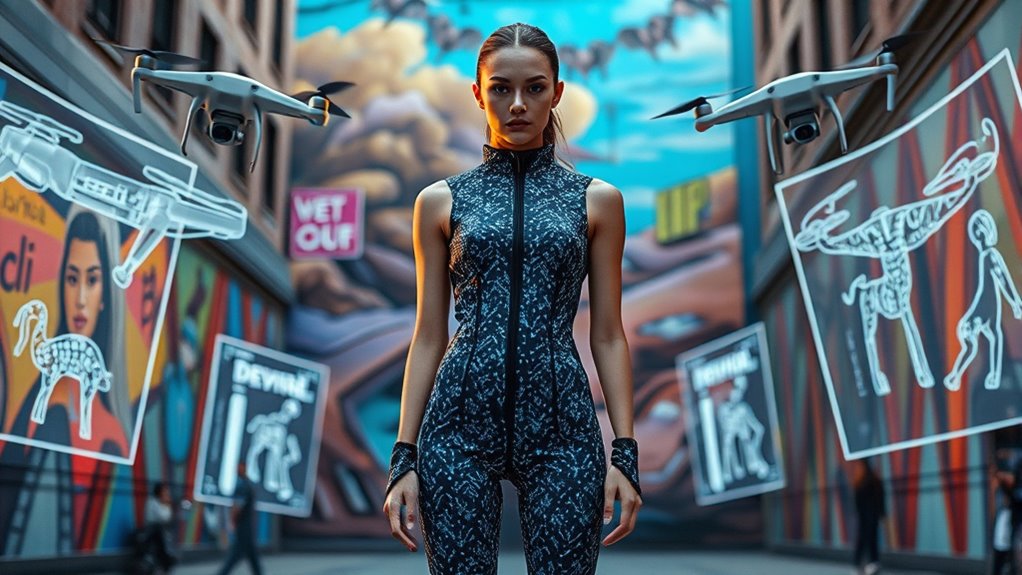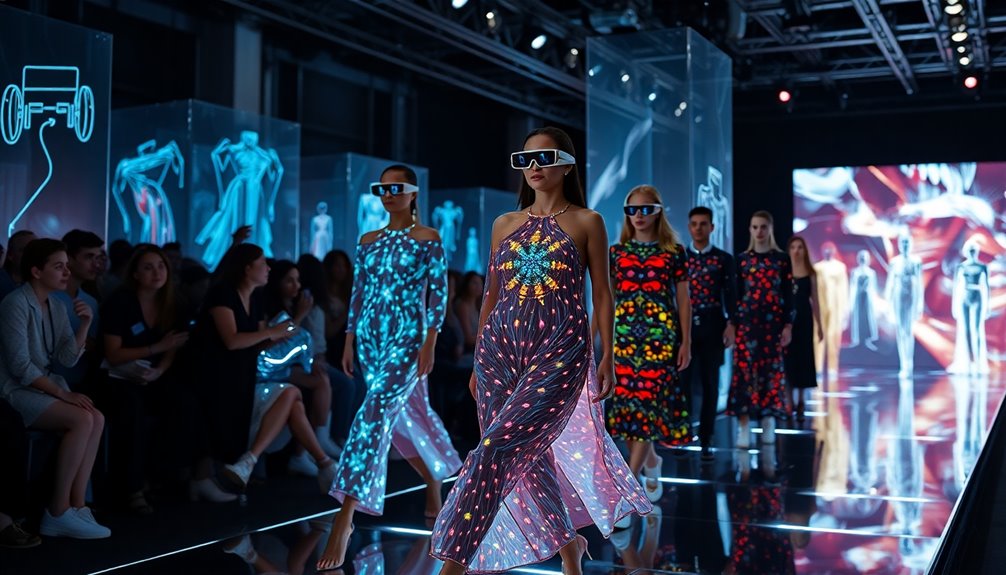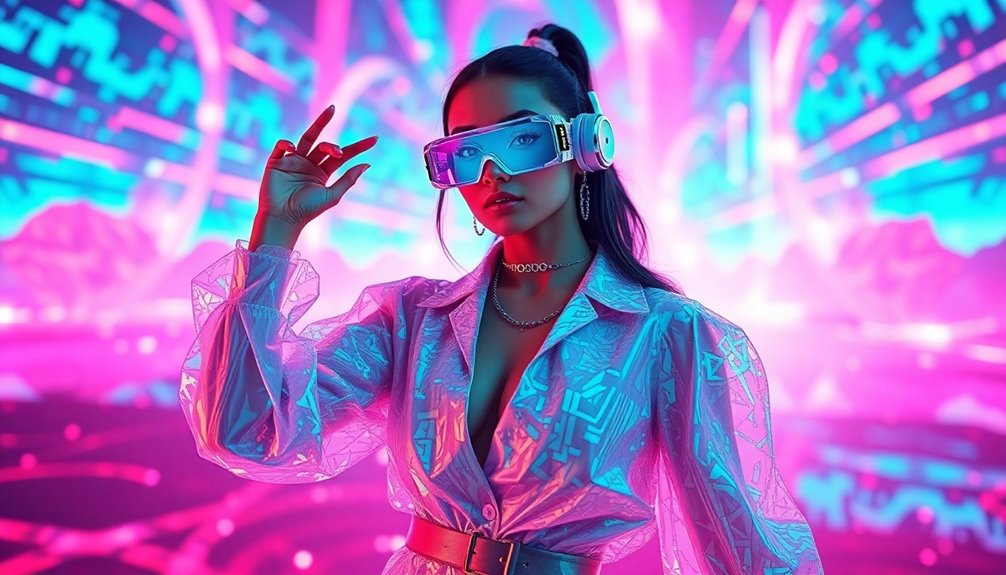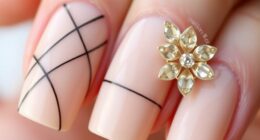Technology is reshaping fashion forever by transforming design, production, and consumer experiences. With tools like CAD, virtual reality, and AI, designers can create and prototype faster than ever. Automation and 3D printing streamline manufacturing, cutting waste and enhancing precision. Plus, you’ll enjoy personalized shopping through virtual try-ons and AI recommendations. These advancements not only improve the industry but also redefine how you connect with fashion. There’s so much more to discover about this evolving landscape ahead.
Key Takeaways
- Advanced design tools like CAD and virtual reality enhance creativity and streamline garment prototyping in the fashion industry.
- Automation and robotics improve manufacturing efficiency, reducing production time and costs while maintaining quality.
- Sustainable innovations, including smart materials and eco-friendly textiles, promote environmental responsibility within fashion.
- Consumer engagement is transformed through virtual try-on apps and AI-driven recommendations, enhancing online shopping experiences.
- Continuous technological advancements redefine fashion, fostering exciting opportunities for creators and consumers alike.

As technology evolves, it’s reshaping the fashion industry in ways we never imagined. You might be surprised by how advancements in design tools, like CAD and CAM systems, are revolutionizing the way designers create. These tools facilitate precise fashion design and prototyping, considerably reducing lead times.
Imagine a world where virtual reality and augmented reality allow you to immerse yourself in the design process, enhancing your creativity and pushing the boundaries of what’s possible. Digital sketching software enables quick modifications, making it easier than ever to iterate on your ideas and streamline the concept process. With hyper-realistic prototyping, you can visualize garments without needing to create physical samples, saving both time and resources.
Envision a future where virtual and augmented reality elevate creativity, allowing seamless design iterations and hyper-realistic garment visualization.
The production side of fashion is also witnessing a tech-driven transformation. Automation and robotics are optimizing manufacturing processes, enhancing efficiency without sacrificing quality. You’ll see that AI-driven quality control systems improve defect detection, streamlining supply chain logistics and ensuring that what you wear meets high standards.
3D printing takes it a step further by enabling rapid prototyping and production of complex garments and accessories. Lean production methods foster agility, reducing waste and increasing precision, making the entire process more sustainable.
Speaking of sustainability, technology is paving the way for eco-friendly innovations in fashion. Intelligent textiles are being developed, responding to environmental conditions and user needs, while wearable technology integrates sensors for health monitoring. Smart materials adapt to temperature changes, and self-cleaning fabrics revolutionize maintenance.
Imagine wearing clothes that can track your physical data and provide personalized feedback, enhancing your everyday experience.
On the consumer side, technology is enhancing engagement like never before. Virtual try-on apps allow you to see how clothing looks on you before making a purchase, improving your online shopping experience. AI-driven platforms offer personalized recommendations based on your preferences, making it easier to find what you love.
Social media plays an essential role in shaping fashion trends, providing instant feedback and fostering brand loyalty through interactive marketing. With data-driven trends, predictive analytics help identify emerging styles, keeping you ahead of the curve.
In this tech-savvy world, the fashion industry is evolving rapidly, making it an exciting time for both creators and consumers. Embrace these changes, and watch how they redefine your relationship with fashion forever.
Frequently Asked Questions
How Is Technology Influencing Sustainable Fashion Practices?
Technology’s influencing sustainable fashion practices in several ways.
You’ll find 3D printing reduces waste by allowing precise production, while biodegradable fabrics decompose naturally, cutting down landfill contributions.
Eco-friendly materials and digital manufacturing enable efficient resource use.
Additionally, AI helps customize fits, minimizing returns and waste.
Virtual try-ons enhance your shopping experience without physical samples, and data analytics streamline supply chains, promoting ethical and sustainable production practices.
Embracing these innovations can make a real difference.
What Role Do Social Media Platforms Play in Fashion Technology?
Social media platforms play a vital role in fashion technology by rapidly disseminating trends and enabling direct interaction between brands and consumers.
You can discover emerging designers and styles through visually appealing content, making fashion more accessible.
These platforms also allow brands to monitor trends and personalize marketing efforts, enhancing customer engagement.
How Are Brands Using AI for Customer Personalization?
Brands are using AI to enhance customer personalization by analyzing your data, like purchase history and social media interactions. This helps them predict your preferences and suggest products that match your style.
With AI-driven fitting solutions, they guarantee accurate size recommendations. Plus, personalized marketing messages resonate more with you, increasing engagement and loyalty.
What Are the Implications of Virtual Fashion Shows?
Virtual fashion shows have several implications for you as a viewer and consumer. They democratize access, allowing you to enjoy shows from anywhere with an internet connection.
You’ll find the experience more inclusive, as diverse designers gain visibility without traditional barriers. Additionally, these shows promote sustainability by reducing waste and emissions.
You’ll also notice cost savings for brands, leading to more innovative designs and digital merchandise that enhance your shopping experience.
How Does Technology Affect Traditional Fashion Retail Jobs?
Did you know that 85% of fashion retail jobs are now shifting towards digital skills?
As technology advances, traditional roles in fashion retail are evolving rapidly. You’ll need to adapt by mastering new tools like AI and digital design software.
Automation is streamlining processes, and understanding these systems can enhance your value in the workplace. Continuous training will be essential to stay relevant and meet the demands of this fast-paced industry.
Conclusion
In a world where pixels and fabrics intertwine, technology’s revolution in fashion is unstoppable. From virtual try-ons to sustainable production methods, you’re witnessing a transformation that’s not just about looking good but feeling good about your choices. Embrace this fusion of innovation and style, as it shapes not just what you wear, but how you connect with the world around you. The future of fashion is bright, and you’re right at the forefront of it all.










